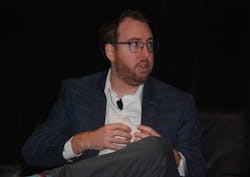Pharmaceuticals swallow the digital-transformation pill
The Life Sciences Industry Forum at Automation Fair focused on digital-transformation imperatives in the industry. Moderator Daniel Matlis, president and founder of Axendia, was joined by panelists Sachin Mirsa, global pharmaceutical and biotech industry practice lead at Kalypso; Mark Auger, senior principal engineer of automation engineering at Cytiva; Carlos Martinez, associate director of MS&T at Sarepta Therapeutics; and Matthew Laing, senior director of digital manufacturing engineering at Eli Lilly.
Matlis began by presenting some research done by Axendia, an analyst firm that provides advice to life-science executives on business, technology and regulatory issues. He also provided an overview of FDA regulations and guidance, as his company has a strong relationship with the agency and has been involved in several digital-transformation initiatives with the FDA.
Axendia’s research identified the top drivers for digital transformation as the ability to make data-driven, intelligence-based decisions, enhancing manufacturing efficiency, throughput and yield, and improved product quality.
“Compliance is the baseline in our industry,” Matlis said. “What's interesting is when we asked, ‘What are the primary barriers to digital transformation?’ Only 1% told us that the barrier is technology. Technology is mature; the technology exists today. It's been proven; we just need to implement it.”
The barriers to adopting digital-transformation initiatives include the need to make a business case (27%), regulatory compliance (32%) and, at the top of the list, company culture (40%).
The pharmaceutical industry is quick to blame regulators as a barrier, Matlis said, but, starting in 2009, FDA began several transformations focused on digital initiatives. FDA implemented the Technology Modernization Action Plan in 2019 and the Data Modernization Action Plan in 2021 and, this year, implemented the Enterprise Modernization Action Plan. Last year, FDA also started the Office of Digital Transformation, focused on cloud strategy and the continued adoption of as-a-service models. “The agency is moving all of its systems to the cloud,” Matlis said. “So, the next time your quality department says the FDA isn’t going to allow us to use cloud solutions, you can point them to the Office of Digital Transformation.”
In September 2022, the FDA launched new draft guidance for computer-software assurance for production and quality system software. The final guidance should be released the first quarter of 2023. Matlis said the focus is on critical thinking and flipping the process, where records and documentation are of value to the organization first, and then also meet regulatory requirements.
From there, Matlis opened the discussion with the forum’s panelists, and he started by asking the group about the most important considerations for building a digital-transformation strategy.
“I think the first thing, from a fundamental perspective, that you have to have is a business case,” Laing said. He works at Lilly, where he focuses on data for the company’s automation system and accelerating the organization’s use of digital manufacturing technologies. Once an organization has established the business case, consider the foundational infrastructure needed to support that digital success, Laing added.
Mirsa, who leads Kalypso’s global pharmaceuticals and biotech industry practice, agreed that the business case is where to start, but also points to culture as a part of that process. “You have to take into account whether the organization is ready to adopt and embrace that change,” Mirsa said. “Culture eats strategy for breakfast,” he added. Mirsa also recommended implementing digital strategies in small phases that build momentum to drive larger adoption.
It is not a lack of data that inhibits digital transformation, he added. “We’re data rich but information poor,” Mirsa said. “A lot of our approach is to assess what data exists and how we can contextualize it.”
Even with all the data in one place, that doesn’t mean it is properly contextualized. “We have a data lake where we pull in all the data,” Laing said. “But just because you’ve landed in one spot doesn’t mean you actually got rid of your digital silo.” He also makes a distinction between being digital and being electronic. True digital understanding requires fully integrating that data with the systems in context.
Many barriers exist for digital transformation in the pharmaceutical industry, including changing practices to focus on solving an organization’s problems first, then applying the right technology for that problem. For large organizations like Eli Lilly, Laing said it can be hard to initially move the needle. “You can’t move it all at once,” Laing said. “But here’s where technology can really help us solve that true problem.”
“Our industry is risk averse,” said Martinez, who oversees the implementation of large automation projects at Sarepta Therapeutics. “People are always very unwilling to change, but once you provide value to them and visibility, I think it changes the culture.” It’s most important to ask, he said, “What value are you providing, and how does it make you more agile and more effective?” And the answer is not any one technology to meet all the challenges but the right technology for the company’s specific application. The process is also dependent on a common information model, which can evolve over time, Mirsa said. “There needs to be that initiative for excellence,” he added. “You have to take into consideration the cultural aspects. I keep coming back to culture because it is a very risk-averse industry.”
Matlis introduced price control as a big concern for the industry. The Inflation Reduction Act of 2022 includes some language that would allow the government to negotiate drug prices, which will create significant price pressure within the industry, he said. “The only way to make that up is to shorten time to market,” Matlis said, and he asked the panelists how organizations are using technology to support accelerated product launches.
Mirsa said there are multiple strategies, but his main point focused on not disrupting organizations in terms of their focus on science. They may still want to produce PDF documents that hold little data value, but natural language processing technologies can extract the data and restructure it in a format that can be leveraged. The other area to expedite time to market, Mirsa said, is with virtual commissioning. “What you can do with today's technologies is design that entire facility, design the lines with the assets and simulate the behavior of the assets. You can even optimize the PLC logic,” he said.
Laing said Eli Lilly is looking at digital tech transfer tools, but, in terms of culture change, those tools represent a big hurdle for the industry.
Martinez also pointed toward simulation. “We leverage simulation in order to do testing, and I think that reduces the amount of time required to do commissioning,” he added.
Mirsa also recommended looking at how other industries have accelerated production, moving from predictive to prescriptive maintenance practices. In the pharmaceutical industry, tying those predictions directly into the control layer may be problematic for the industry. He suggested keeping humans in the loop, an operator to review that decision and physically make the control adjustment.
Laing delivered a strong message around standardization. “Just to streamline equipment delivery, one of the biggest things that we’ve done is standardize the processes and the equipment,” he said. Eli Lilly has undertaken a standardization project to connect legacy standalone instruments that were never connected before. “We did a large global project that put in the foundation for us of our IoT messaging,” Laing said. “Then, we built containerized modules that can connect to all of these different instruments no matter what the vendor.” Down the line, this can enable plug-and-play concepts, which can help accelerate time to market.
For updating legacy equipment, Laing also said defining standard interfaces is paramount. “It’s all about finding those standard interfaces between systems,” Laing said. It doesn’t matter what the underlying technology is. “If the interfaces are standardized, it becomes plug-and-play.” Standard interfaces also help ensure consistency and drive quality, he added.
Matlis also focused the conversation on the cloud and whether that can drive speed to market and production efficiency. Mirsa said he’s seen a rapid uptick of cloud solutions, but those will likely remain a hybrid solution for the foreseeable future. He did caution pharmaceutical companies that want to adopt the cloud to consider how that will impact their validation organizations. “If you adopt cloud, you have to make sure your validation resources can keep up with the cadence of the updates,” Mirsa said.
Laing said Eli Lilly has a cloud-first strategy but supports the hybrid infrastructure, where critical operations remain on-prem.
Get the best of Automation Fair 2022
When the event comes to a close, the best, most important coverage will be compiled into a report. Register now to pre-order the report and be among the first to receive it in your inbox.
Continue Reading

Leaders relevant to this article:

